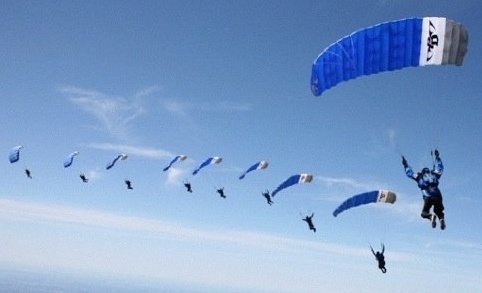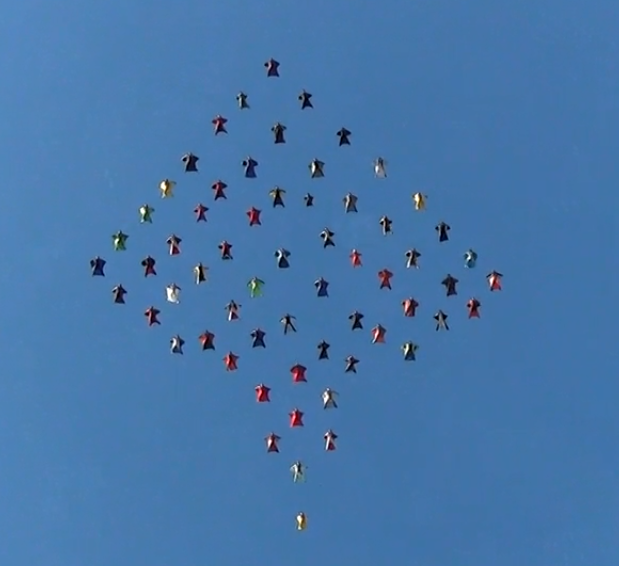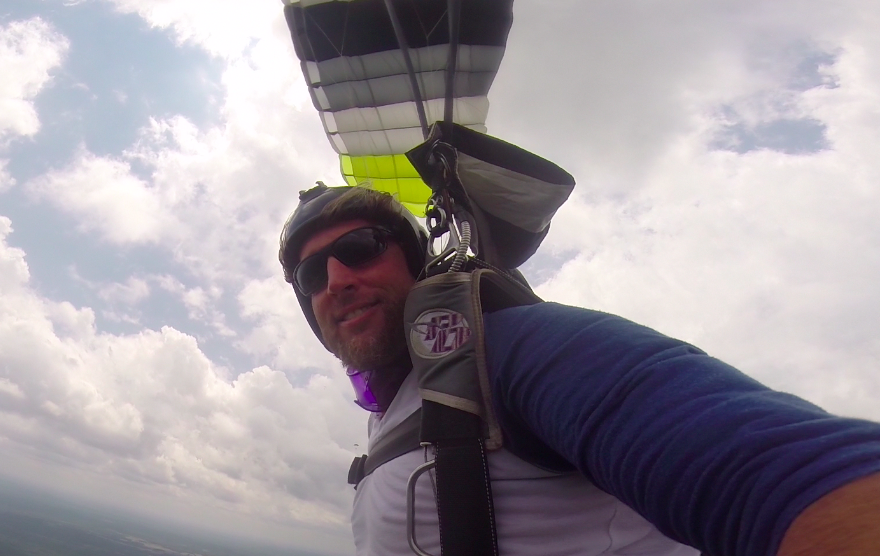Recommended Posts
QuoteQuoteHow do you avoid crossing these windows? One way to do this is with similar groups, canopy size dictates exit order, i.e.: two 4way teams, one with sub 100 canopies, and the other with 135's.
Rdutch you have way more jumps and experience so my questions are out of pure curiosity.
1. What about two 4 way teams with mixed canopies on each team. Which team goes first?
2. Would wingloadings play into this more than canopy size? Say someone on a 150 loaded at 2:1 compared to someone on a 119 loaded at 1.4:1.
Just curious.
communication between teams is the answer
Dave
CSpenceFLY - I can't believe the number of people willing to bet their life on someone else doing the right thing.
QuoteThe bottom line is that I can keep a visual on the target at all times while doing a 180, though I don't recommend a 180 in traffic.
I absolutely guarentee you that you are not able to watch for the traffic you are flying directly TOWARDS for a 180 and perform your turn safely. Most, if not all, pilots will be focusing on the ground since that's where the perceived (and rightly so) danger is.
A 180 will never, ever be any less dangerous than a 270 with regards to traffic.
Blues,
Ian
QuoteA 180 will never, ever be any less dangerous than a 270 with regards to traffic.
Plus (at least IMHO), it is not nearly as accurate when it comes to setting up and being precise.
Try not to worry about the things you have no control over
winsor 236
QuoteQuoteThe bottom line is that I can keep a visual on the target at all times while doing a 180, though I don't recommend a 180 in traffic.
I absolutely guarentee you that you are not able to watch for the traffic you are flying directly TOWARDS for a 180 and perform your turn safely. Most, if not all, pilots will be focusing on the ground since that's where the perceived (and rightly so) danger is.
A 180 will never, ever be any less dangerous than a 270 with regards to traffic.
Blues,
Ian
"Directly towards" at which part of the turn? You are going a different direction at the beginning and the finish.
A 180 and a 270 have similar issues with regard to increased danger, but a 270 has the added problem of being an OUTSIDE turn. A 180 is an INSIDE turn.
From the standpoint of safety (or lack thereof) in the pattern, both suck, but a 270 is more dangerous by virtue of having much more significant blind spots (you have your back to traffic while executing the maneuver).
Blue skies,
Winsor
http://www.dropzone.com/cgi-bin/forum/gforum.cgi?post=2835281;#2835281
Hope this helps clarify what I'm driving at.
Blues,
Ian
rehmwa 2
Quotewith similar groups, canopy size dictates exit order, [instead of group size]
Completely agree. Similar group mean fall rate categories - 'between' fall rate categories drift still trumps.
QuoteEDUCATION ......Proper procedures can be added to AFF to address your entire canopy flight. It happens in pilot training and should happen in skydiving.
Just about turned off from seeing all caps on the mantra. No kidding (glad I didn't, the whole post is nicely written). But in training early in the process is a great idea. Drift, canopy flight, etc - how to get along with others on the load is missing I think.
Quote{big groups, have a landing order} The jumpers with the smallest canopies land first, and in return the jumpers with the largest canopies land last,
Important, if you are tagged to get down first, PLEASE get down and out of the way. Sitting in the bottom of the stack and then holding half brakes just stacks up everybody above you and tempts them to go ahead and take that big ol' 100 ft hole you have below you. I really hate this, if you make a big deal about getting out first because your (my) canopy is smaller, then get the hell down.
Quotepilots that perform high performance landings will have to get out in the back of the plane, maybe because their dropzone has a freeflyers exit after belly flyer rule,
I really hate seeing this all the time. EVERY discipline has high performance pilots.
Quoteif you have to swoop, then you have to pull higher. Want more freefall, then don’t swoop. And of course once open, ride your brakes! You need to use your judgment to decide when it is safe to swoop and when it is not. High performance landings can be safe but doing them in a crowd is just a bad idea.
It's VERY frustrating to see staff AFF and Cameramen (out last) spiraling down through traffic and swooping through others and cutting next to the wuffos. How do we eliminate that bad example?
Quotea 270 safer is you have
actually I see this, but there's a lot of assumptions hidden in the background of the comments about how people do 180's that I think are wrong. Even if using the same techniques (carve it, etc) I still think that a 270 gives a better ability to setup right before the hook. Still, depends on the individual so there'll always be some nonsense.
One thing to the naysayers - If you are BEHIND someone in the pattern, then you should be ABOVE and BEHIND. So if they do a front riser 270 onto final, you should be completely safe (unless YOU choose to crank your 90 before he makes his move and cause the intersect). If you are below him, he should be able to see you 90 or 180 or 270......
I still think that separate landing areas is best if a DZ has the real estate. And that the high speed should be away from the wuffos for the safety of the wuffos in the event a landing goes bad. But, whatever type of landing the DZOs do, that's what will be near the hanger.....
...
Driving is a one dimensional activity - a monkey can do it - being proud of your driving abilities is like being proud of being able to put on pants
QuoteBut, whatever type of landing the DZOs do, that's what will be near the hanger.....
ROFLMAO ... how true ...
Try not to worry about the things you have no control over
The111 1
QuoteHere's the diagrams I use when teaching. They clearly show just how instrusive (more so than ANY other type of turn) a 180 is.
http://www.dropzone.com/cgi-bin/forum/gforum.cgi?post=2835281;#2835281
I'm not sure I got that from the pictures. Could you elaborate?
Also, why does the 270 illustration show the maneuver taking up virtually no space at all, while the 180 looks like a broad sweeping parabola?
The111 1
The truth is anybody can draw a picture to illustrate a point in theory, but in real life, at the DZ, it is always more chaotic. There is always a new jumper flying the wrong way. Hell, I usually see 25% of the load flying the wrong way or landing crosswind depending where I am. No matter how great of a swooper you are, common sense dictates that the higher degree of turn you do:
1) The faster you go
2) The more you have to be aware of (due to the rapid change in direction and accordingly your blind spot)
Both of these things make it harder to avoid an unexpected canopy in your path, and again no matter how good you are, there will someday be an unexpected canopy in your path (especially on twin turbine loads when 20 people are under canopy at once).
I am not saying 180's aren't without their risks, but I can see where they would be preferable to 270's. It's the same reason we tell students not to do S-turns in the pattern. Collisions aren't as likely when you're going straight; they are more likely when you're turning. Car crashes usually happen at intersections. More turns = more collisions. Larger turn is analagous to more turns.
I'm sure many swoopers are capable of doing 270 degree turns in traffic, just like I'm capable of driving 100 mph in traffic down the highway. I will get ticketed for going over the chosen limit of 70 mph though, regardless of my ability or my opinion. And if I am totally honest with myself I'll admit that 70 mph is safer, for that one day when the car in front of me changes lanes unexpectedly.
kallend 2,216
The only sure way to survive a canopy collision is not to have one.
QuoteAlso, why does the 270 illustration show the maneuver taking up virtually no space at all, while the 180 looks like a broad sweeping parabola?
The original post already apologizes for the quality of the drawings. The intent is, and clearly so, to depict how intrusive the 180 pattern is. Compress the turn and overlay it with ALL the other turn types and you'll see it in no way conforms to the downwind, base and final paradigm.
edit: Once again I'm NOT arguing for doing 270's in traffic, but rather that the notion of 180's being safer iin traffic is absurd.
Blues,
Ian
Quote
If you want to know why canopy collisions happen, you could always ASK those who have been involved (and survived), rather than speculating.
Ray has jumped, for a number of years, at some of the busiest DZ's in the USA. I wouldn't discount his thoughts simply because he hasn't been in a collision. He's an experienced skydiver who's seen and done a lot.
Ian
When I mentioned it to the showoff that he was being unsafe, his response was, "I looked before I did it."
My response was, "You don't kill people that you see." (Also, "Do it again and you can leave.")
That sums it up for me.
Some of the accidents that I have seen were caused by clueless, new jumpers who flew across the pattern into the side of someone.
The other part were arrogant "I've got Mad Skillz" showoffs.
The pattern and the rules are there for everyones safety. Just because someone has done 2,000 stellar landings, does not mean that they can do whatever they wish.
Arrogance has caused more collisions than stupidity.
QuoteHow do you avoid crossing these windows? One way to do this is with similar groups, canopy size dictates exit order, i.e.: two 4way teams, one with sub 100 canopies, and the other with 135's. Obviously the sub 100-canopy team should exit first. On bigger groups this gets more difficult, but not necessarily. The old standard is that a 10 way exits before a 4 way because a 10 way takes more time to climb out. While this is a good idea it isn’t cast in stone. It is much safer to have a 4way team that is all jumping tiny canopies and performing high performance landings exit first, instead of exiting after and finding themselves in the middle of a landing pattern of 10 big canopies that intend to do straight in landings. Of course when using this method exit order = landing order, it should be this way with any scenario.
Please explain to me how this would even remotely apply to say the most recent canopy collision, where someone with more experience than even you hooked into a crowded LZ and killed someone? Seriously, lay out the scenario on that fateful day in Dublin. The bigway, the camera flyers, a solo, some small canopies, some large canopies... What would the order be.
A dry run, using your theory, that would have saved a life. Please explain it to me.
Because its obvious at least in that scenario, in all probability no hp landings in the main LZ would have saved (most likely) a life, Bobs life.
You see Ray, to most of us this is tangible, something a DZO can do to actively make a difference. Ray Im not here to argue with you, frankly I don't care, personally most of the time unless the main landing area is empty I land in the student area and ride in the truck and this applies to Perris and Deland (two DZ's Ive jumped at in the last year) You see I understand your theory it just doesnt apply to all scenarios, whereas no hp landings in the main area does.
kallend 2,216
QuoteQuote
If you want to know why canopy collisions happen, you could always ASK those who have been involved (and survived), rather than speculating.
Ray has jumped, for a number of years, at some of the busiest DZ's in the USA. I wouldn't discount his thoughts simply because he hasn't been in a collision. He's an experienced skydiver who's seen and done a lot.
Ian
Roger Nelson had seen and done a lot more.
The only sure way to survive a canopy collision is not to have one.
However, as usual (lately), your post doesn't seem to offer anything more than a shot at someone. Seems rather usual for someone who has contributed a lot to other subjects (such as freefall drift and exit seperation).
Is there any reason you intentionally make quips to posters on this subject. Your intent, for whatever reason, appears to be to discount or discredit Ray's thoughts? Maybe I'm just reading into, or mistaking the meaning behind your post(s), in which case I apologize for misunderstanding them.
Ian
rehmwa 2
QuoteThe bigway, the camera flyers, a solo, some small canopies, some large canopies... What would the order be.
A dry run, using your theory, that would have saved a life. Please explain it to me.
I'm on your side, but he did talk about big ways and some of the content was very good. Go back and read the following paragraph starting with "Large group formations are another instance of this problem, in this instance I fully agree on a rule on landing. If you do 270-degree turns on a 30 way, into the regular landing area, you’re an idiot."
There's some good to take from it, and some to reject, but the discussion is worthwhile still.
...
Driving is a one dimensional activity - a monkey can do it - being proud of your driving abilities is like being proud of being able to put on pants
rehmwa 2
QuoteSitting in the bottom of the stack and then holding half brakes just stacks up everybody above you and tempts them to go ahead and take that big ol' 100 ft hole you have below you
don't you mean 1000 ft hole?
Why yes, I did.
fine then, try to be more accurate next time
...
Driving is a one dimensional activity - a monkey can do it - being proud of your driving abilities is like being proud of being able to put on pants
winsor 236
QuoteAgreed on Roger Nelson.
However, as usual (lately), your post doesn't seem to offer anything more than a shot at someone. Seems rather usual for someone who has contributed a lot to other subjects (such as freefall drift and exit seperation).
Is there any reason you intentionally make quips to posters on this subject. Your intent, for whatever reason, appears to be to discount or discredit Ray's thoughts? Maybe I'm just reading into, or mistaking the meaning behind your post(s), in which case I apologize for misunderstanding them.
Ian
Let's see.
John and I each have thousands of hours flying airplanes.
John and I each have thousands of skydives.
John and I have experienced canopy collisions and survived.
John and I have advanced technical degrees and have made a living teaching Physics.
John and I have taken the time to analyze the Physics of canopy collision.
There is some merit to raw experience, but it has a limit. If experience was the only yardstick that mattered, a great-grandma who has been driving since she was 16 would be a better driver than Jeff Gordon.
Thus, when someone cites their "experience" to me as credentials regarding a physics issue, it is often like being a Nutrition Physiology researcher trying to decide whether to engage in a discussion with someone who holds the record for eating McDonalds hamburgers.
One of the problems in this sport is that ignorance can kill, and ignorance is often bolstered by arrogance (trust me, I know from arrogance).
What we are trying to do is establish parameters whereby canopy collisions are not quite as inevitable as they now are. Just because you don't die most of the time, the free-for-all approach is not quite optimal.
Insanity is sometimes defined as doing the same thing and expecting different results. We are somehow expecting things to work differently with parachutes than airplanes, and the lessons were learned in airplanes a long, long time ago.
I have landed an airliner right after a Cessna Skyhawk, and have landed a Cherokee ahead of a MiG, with no problems. Landing disparate types is no great feat, but there are ways to approach it that routinely result in disaster.
I can land one of my cross-braced Class VI canopies among students under Mantas with no problem. If, however, I insist on doing a High Performance Landing because I am under a High Performance Canopy, all bets are off.
If someone chooses to put forth an argument that is devoid of merit, one must decide quite how much time to waste addressing the fallacies contained therein. When they put forth a "solution" that has been tried and found wanting every time, it does not warrant a lot of discussion in and of itself. Giving someone credit for being able to figure out the fundamentals is often unjustified.
Blue skies,
Winsor
Blue skies,
Winsor
People will pick this apart and try to discredit the post.
Education IS the answer...nothing can replace experience but you can arm yourself with as much knowledge as possible.
People...read the post...take away from it what you want and leave the rest.
Regardless....we as sky-divers will continue to die...try not to let it be you, if it is, try not to take anyone with you.
Better you than me
..................................
QuoteEducation IS the answer...nothing can replace experience but you can arm yourself with as much knowledge as possible.
And neither of these things will make any difference when a HP Canopy Pilot makes a mistake and doesn’t see that slower canopy already on Final when they start their 180 or 270. Then it is too late.
How are you going to "Educate" these people with 1000`s of jumps that already think they are bullet proof??
Humans make mistakes. They will continue to make mistakes no matter how much education they have.
Education is a nice concept, but it isn’t going to change the fact that we don’t have eyes in the back of our head and even if we did there isn’t much we can do when someone is coming out of a Blind Turn (180 or 270) heading straight for us at a very high rate of speed. Nothing we can do at that point but pray.
I spent years working as an Engineer designing and building Industrial machinery. Every machine had to be redesigned constantly because the operator (regardless how much training and education you gave them) would still find ways to hurt themselves and/or others. We had to design the machines where it was harder and harder for the operators to do that. Still they would find a way.
Same here. We have to make it harder for people to find a way to have canopy collisions. Right now it is very easy for this to happen. All it takes is One canopy pilot not seeing Someone else till it is too late. Separating Fast Moving canopies from slow moving canopies is necessary to accomplish that.
Quotewe as sky-divers will continue to die...try not to let it be you, if it is, try not to take anyone with you.
Absolutely. If you have to Swoop, Do it where you are not putting others in danger.







Rdutch you have way more jumps and experience so my questions are out of pure curiosity.
1. What about two 4 way teams with mixed canopies on each team. Which team goes first?
2. Would wingloadings play into this more than canopy size? Say someone on a 150 loaded at 2:1 compared to someone on a 119 loaded at 1.4:1.
Just curious.
"You start off your skydiving career with a bag full of luck and an empty bag of experience. The trick is to fill the bag of experience up before your bag of luck runs out."
Share this post
Link to post
Share on other sites